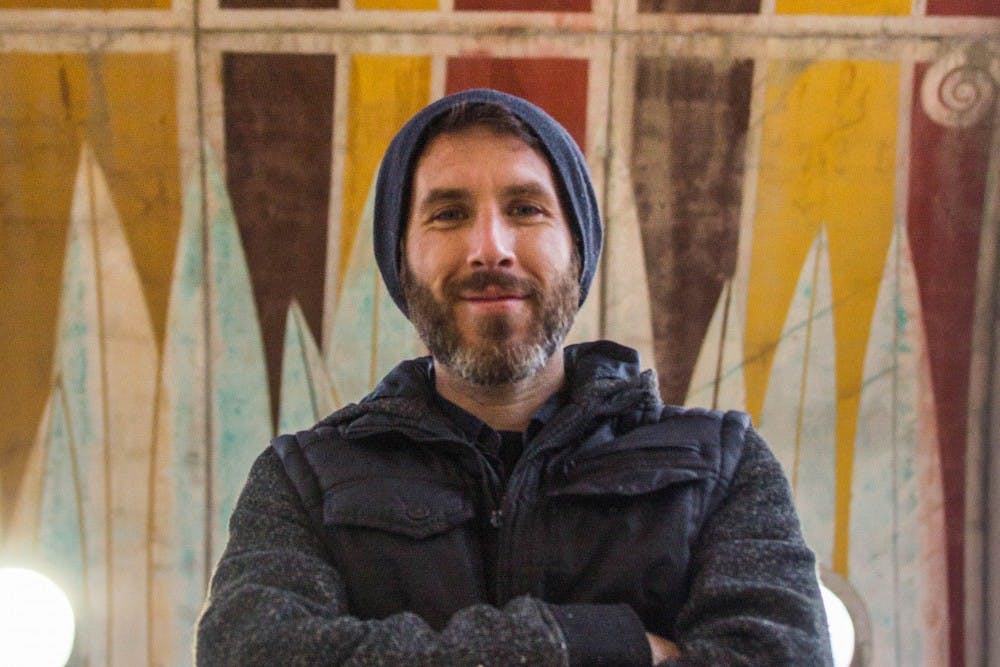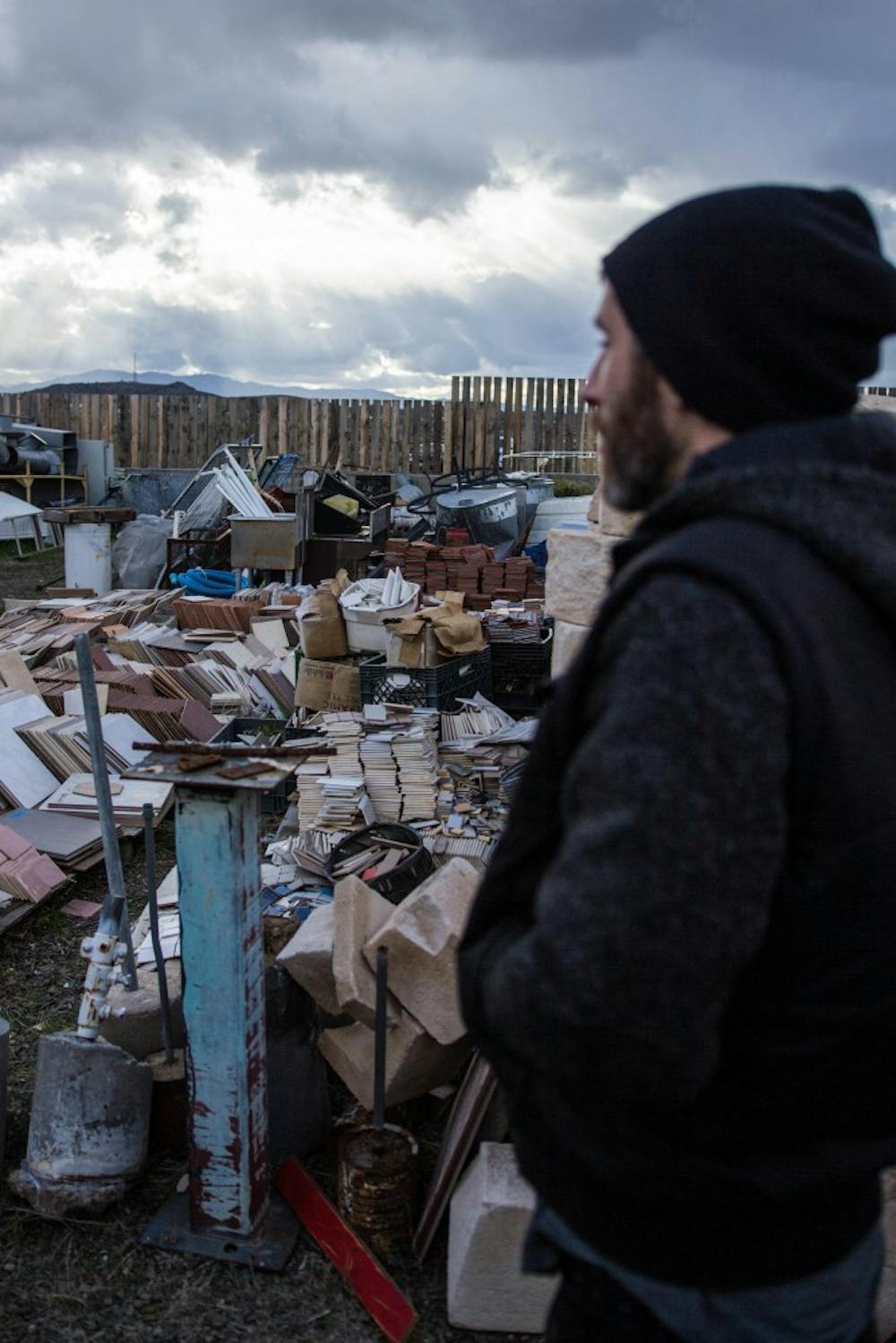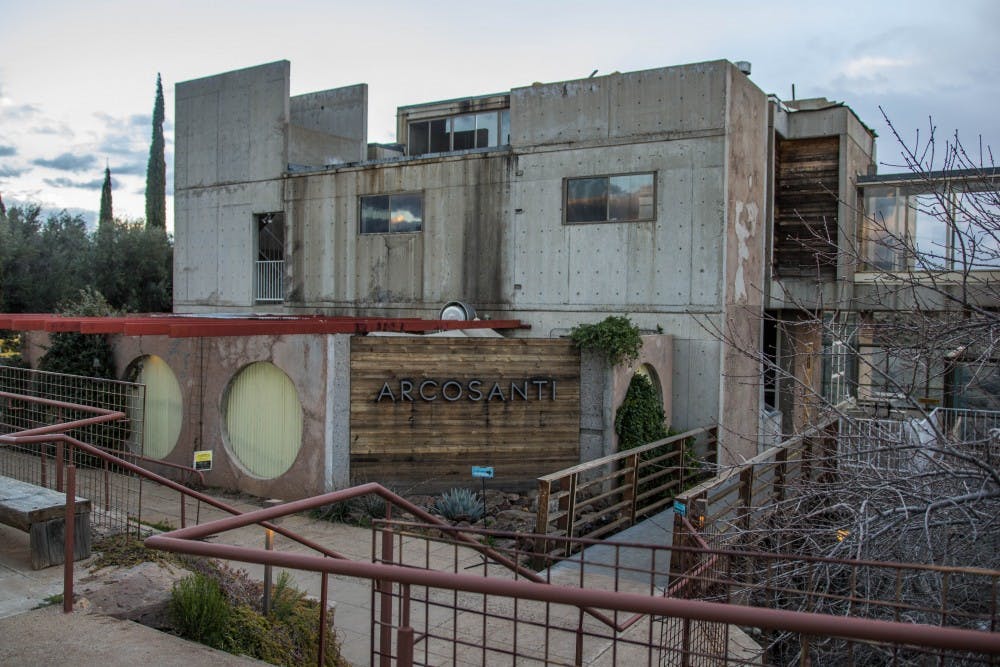In Rob Jameson’s makerspace, a sunlit room adorned with journeyman’s tools and various materials meant for creating, Jameson reflected on the lifestyle he has become accustomed to living at Arcosanti. To say the least, he's satisfied.
“It’s fucking awesome, man.”
A small experimental community located in the central Arizona desert, just off the I-17, Arcosanti sits halfway between Phoenix and Flagstaff.
Envisioned in the 1970s by Italian architect Paolo Soleri, every element of Arcosanti is supposed to originate from the concept of arcology, the blending of principles from ecology and architecture. Soleri had a master plan for the town: a completely self-sustained, eco-friendly and collaborative community designed to accommodate about 5,000 residents.
One part of the urban laboratory, "the slab," is a sorted junkyard that is off-limits to most visitors. A look around the slab did not at first imply that there was any rhyme or reason to its layout.
“This is a perfect case study for a failed system,” said Jameson, who has lived at Arcosanti four years and is the chief officer of marketing and technology. Jameson made clear his frustration with the system that was put in place to deal with the excess materials.
To many, the slab would look like a hoarder’s open-air daydream. Items ranging from old couches to tiles to discarded parts of walls were strewn across the dirt inside a small, fenced area.
To the residents of Arcosanti, this collection is a part of their sustainability-focused economy and is a small step into the future of their community.
But that’s only if they can find a way to efficiently recycle and reintegrate the materials.
That’s where Greenlight Solutions at ASU came into play. Greenlight Solutions is a group of students and alumni focused on bringing sustainable practices to businesses and to the general exploration of eco-friendly alternatives through various projects and partnerships.
Greenlight makes semesterly visits to Arcosanti to hold retreats and assist on projects relating to sustainability and engineering. During retreats, the “solutioneers,” as the students are known, have helped organize the cluttered slab into a form of organized chaos, which they now call "the yard."
Turning the slab into the yard goes deeper than a name change. Through systematically categorizing the waste, Greenlight and Arcosanti residents are making waste recycling more feasible, all part of Arcosanti’s goal to establish what is called a circular economy.
Circular economy denotes a system of waste management focused on cumulative waste reduction. The concept relies on three principles: reduce waste completely, keep products and materials in use and regenerate natural systems.
This economic system was brought to Jameson’s attention by Greenlight member Connor Damaschi. Damaschi has been a project manager for Greenlight in Arcosanti for the past year and a half.
“A lot of people (in Arcosanti) want to see progress as they see Arcosanti can move forward and push these new sustainable practices,” Damaschi said.
Greenlight and Arcosanti got involved in a story-like way, with Jameson meeting Greenlight founder and ASU alumnus Kevin Kelehar at Ancient Future in 2017, a “cosmic celebration” featuring music and art in Phoenix.
“We were out. He was spinning poi. I was juggling devils sticks, having a grand ole’ time. (We) became best friends,” Kelehar said. “He invited me to host Greenlight for a retreat (in Arcosanti).”
Kelehar said after he visited the first time, he immediately fell in love and decided to move to Arcosanti in February, 2018.
“I see Arcosanti as a great place to continue to hold retreats, to be inspired and make sure our vision is aligned and also bring some of the great ideas of (Arcosanti) to the community,” Kelehar said.
ASU alumnus Ryan Mores is the co-founder and operations director of Greenlight. He said the work the group does in and outside of Arcosanti is not only valuable but necessary in terms of the future of sustainability.
Greenlight has worked with over 40 local businesses in a variety of ways. It often helps create strategic plans for businesses looking to be more sustainable and also get hands-on in certain projects.
“Sustainability is not a fad or a trend, it is something that is going to be here for the long haul,” Mores said. “The new way of business is to be sustainable and look at that triple bottom line. We’re not just worried about profit anymore, we’re worried about the people and the planet.”
The concept of a circular economy is taken into consideration when Greenlight is creating its business strategies. Mores said the principles of a circular economy are only going to get more prevalent in the near future, and spreading insight on them now provides benefits for both businesses and the planet.
"The current system is not sustainable. We can’t continue to just consume, consume, consume and send everything to the landfill. The earth does not have the carrying capacity for that,” Mores said.
Greenlight has assisted heavily in bringing circular economy principles to Arcosanti, and the town has been receptive of the concept. Jameson said there is still a lot of work to do in terms of cleaning up and morphing Arcosanti toward its fully sustainable potential.
“Arcosanti, although it’s a little bit dusty, and maybe it’s a little in need of a pep-start, the ‘why’ of why this place exists is still super relevant,” Jameson said.
Soleri’s brain-child has thus far been unsuccessful, with the number of residents since 1970 ranging from 50 to 150. The proposed utopia may or may not be in Arcosanti’s future, but the vision still exists at the very least in the minds of those who live there. Soleri’s vision permeates the principles of the experimental micro-city, such as shared resources among residents and zero-commuting.
Barrett faculty fellow Michael Ostling takes his students to Arcosanti to study utopian and dystopian societies. The goal of each visit is to examine a real-life attempt at constructing a utopia, to analyze what went wrong and what has actually worked.
“Soleri thought that if he built a city just right, then everything else would follow. People’s behavior would change, their relations would change, economics would change. Like all utopias, it failed,” Ostling said. “On the other hand, it’s pretty cool.”
Despite the failure of Soleri’s vision, Ostling said most utopian attempts at least sow the seeds of new ideas. A standout concept in Arcosanti, Ostling said, is the idea of a shared community.
“Arconauts,” another name for the residents of Arcosanti, have their own small personal living spaces but share a majority of resources, such as studio spaces, a cafe and a pool. Ostling said this shared space model has similarities to mixed-use living arrangements in urban areas, where residents often work, shop and play in the same place.
Although the living situation in Arcosanti is comparable in some ways to the millennial urbanite lifestyle, Jameson said one aspect Arcosanti is missing is what he calls “digital nomads,” or those who solely work online.
Because of communal work commitments, which have every resident doing a variety of practical work for the sake of community upkeep, Jameson said digital nomads would not be able to fit the part of an Arcosanti resident.
Jameson said the living situation in Arcosanti will only gain more relevancy as more young people are moving to cities and urban environments.
“You trade having a large space that is your own domicile for having a small space, but access to shared resources, access to people,” Jameson said. “The kind of centralized eco-conscious design principles that they have pioneered here are only becoming more relevant as that urban way of living becomes the norm.”
In order to live in Arcosanti, potential residents must finish a six-week immersive workshop to learn the ins-and-outs of the community. Through this, those who live in Arcosanti are able to contribute to the growth of the town in some way.
Jameson said the aligned focus on growth among the residents is helpful beyond construction projects. He and his wife recently had a newborn baby, and his neighbors' help makes him thankful for the unique connections created through the setup of Arcosanti.
“To live in a community with 70 friends that are involved in this journey and will cook us meals if we need them and come over and babysit — it’s just amazing,” Jameson said.
While residents are a vital asset to the betterment of Arcosanti, volunteer work and partnerships are also large help for projects that focus on clean up and the advancement of the town. Financial barriers often slow the progress down, but Jameson said the residential and voluntary dedication towards Arcosanti’s growth is what keeps hopes high.
“It’s changing a lot right now,” Jameson said. “I think for the first time in 20 years we are going to have a budget and permission to actually update and innovate the designs and start the process again of ‘What does this eco-conscious city of the future look like?’”
Arcosanti was initially meant to change the world. After 40 years and the constantly accelerating environmental catastrophe brought about through human activity across the globe, it's fair to say Arcosanti did not accomplish what Soleri thought it could. But Arcosanti still exists, and there are still people who take an interest in the place, contributing from near and far to help the town.
For his part, Jameson said that little by little Arcosanti is progressing toward a future where humans live in harmony with their environment.
Reach the reporter at mmbarbe3@asu.edu and follow @meganbarbera on Twitter.
Like State Press Magazine on Facebook and follow @statepressmag on Twitter.







